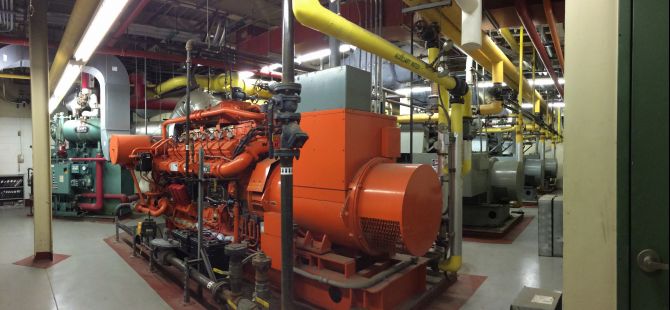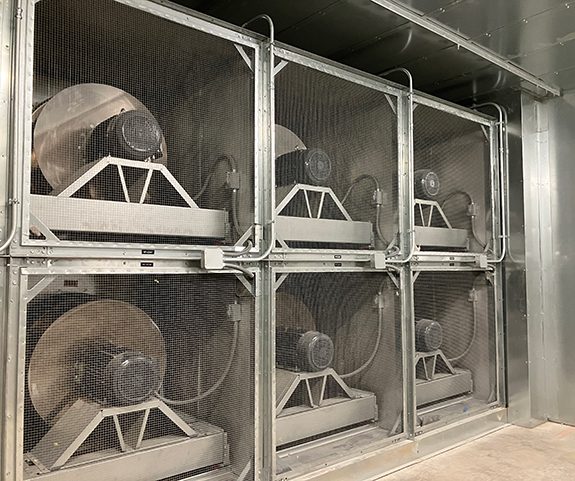ComEd continues to offer incentives for feasibility study of combined heat and power (CHP) systems, sometimes referred to as cogeneration or “cogen” systems.
Potential benefits of CHP systems include:
- Alternative source of power to increase reliability and uptime – ComEd’s grid becomes the standby for electrical distribution served by the CHP system.
- Reduced operating costs depending on the spark spread.
- Decreased source emissions; increased ENERGY STAR Portfolio Manager scores.
- Incentives from ComEd available for feasibility, interconnection, and first-year total efficiency bonus.
CHP technologies allow simultaneous production of electricity and usable heat, representing a thermodynamically efficient use of fuel. G/BA is an approved technical assistance provider for the assessments, which can analyze the performance of existing CHP plants or the feasibility of implementing new ones. Funding support is provided under ComEd’s Energy Efficiency Program. Study incentives are available to facilities with a peak demand of ≥ 500 kW that take electricity delivery from ComEd, regardless of retail supplier.
CHP systems supply at least a portion of a facility’s electrical load and capture waste heat from hot exhaust gases for use in space heating, cooling, domestic hot water, dehumidification, and/or process heating. The ComEd incentive program can be applied to many types of systems:
- Generation of electricity at the capacity of the generator while recovering thermal energy. Typically, thermal loads exceed the capacity of heat recovery equipment in this mode of operation.
- Production of useful thermal heat while electricity generation tracks the heat load. This method requires a prime mover that is efficient at partial loads.
- Operation “behind the meter” serving only the applicable facility loads or connecting to the grid to allow parallel operation.
- Conversion of waste heat to power.
Incentives are available in the following categories:
- Feasibility study (up to $10,000 for CHP projects with capacity under 400kW and up to $25,000 for CHP projects with output greater than 400kW). Studies and projects must be pre-approved. All of the operating cases mentioned above are eligible, including existing installations that can be modified for increased electrical conversion efficiency or addition of heat recovery to systems that currently are electric-only.
- Production incentive ($0.07 per eligible kWh, based on a 12-month measurement and verification [M&V] period).
- Interconnection fees (up to $15,000, available to offset fees to ComEd for electrical infrastructure).
Prepayment of $60/kW is available on receipt of commissioning documents that confirm construction completion, capacity, and efficiencies of the project, and requires at least one month of successful system operation. Remaining incentive funds will be distributed after 12 months of operation with associated M&V. Projects with simple payback periods greater than seven years, or incentive amounts of $50,000 or greater, may be subject to further eligibility evaluation.
CHP 101: An Introduction to Cogeneration
CHP or cogeneration can take several forms:
- Electrical generator(s) including an engine. Reciprocating engine cogeneration systems are common in the 200 kW to 2,000 kW capacity range and may be installed in parallel to allow a greater total capacity. Reciprocating engines frequently use natural gas and maintain efficiency over a range of output compared with other options, with a quick start-up time.
- Smaller systems may include microturbines with capacities from 25 kW to 500 kW each. These systems tend to provide a lower electrical conversion efficiency with more heat available. They also are often low-NOx and can be installed as a modular plant for larger capacity, and can be selected to use biogas as a renewable fuel source (or propane in remote locations where natural gas is not available).
- Larger systems may include steam turbines (driven from a boiler) or combustion turbines (most often natural gas, but also other gaseous or liquid fuels). Steam turbines can be selected from 100 kW to 250 MW. Combustion turbines are typically used in industrial applications, large healthcare campuses, and at utility scale up to 300 MW.
- Heat recovery from stack exhaust (all types) or engine cooling components (reciprocating engines).
- An absorption chiller using heat recovery in the summer in a combined cooling, heat, and power (CCHP) system.
Good candidate facilities include sites that have a need for thermal energy year round, or that have absorption chillers to use thermal energy in the summer if reheat or process loads aren’t otherwise sufficient to support a CHP system. Facilities that would benefit from added reliability of electrical service are also particularly good candidates for CHP assessments.
After the assessment process is complete, a final report will be delivered. Such a report will generally include the following items:
- Site description (including building operations, utility sources, and utility use profiles).
- Current site energy efficiency status.
- Description of the evaluated CHP project (including major equipment and efficiencies, as well as interconnection requirements)
- Functional performance of the recommended CHP project (including a detailed breakdown of major line items, operational costs, expected savings, and the customer’s method of financing the implementation).
- Permitting requirements.
- Metering plan (for measurement and verification of the project, post-implementation).
- Description of the proposed project team.
- Anticipated implementation schedule.
For clients with suitable facilities and objectives, CHP systems can provide great benefits, maximizing the investment in energy resources and improving the sustainability profile. ComEd’s assessment incentive gives owners an economical method for studying the possibilities. Contact G/BA today to discuss whether a CHP assessment makes sense for your facility or campus.



